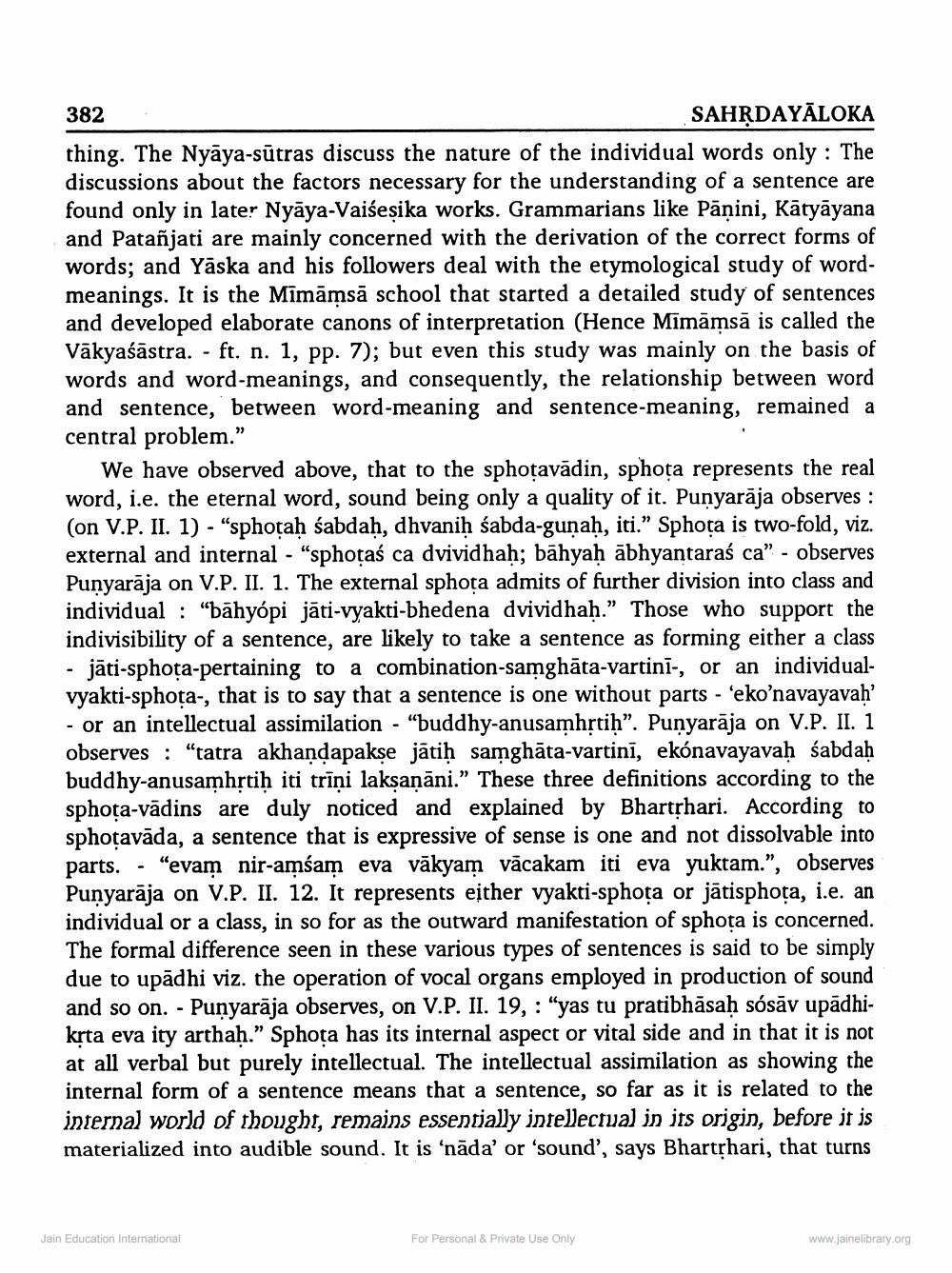________________
382
SAHRDAYĀLOKA thing. The Nyāya-sūtras discuss the nature of the individual words only : The discussions about the factors necessary for the understanding of a sentence are found only in later Nyāya-Vaiśesika works. Grammarians like Pāṇini, Kāryāyana and Patañjati are mainly concerned with the derivation of the correct forms of words; and Yaska and his followers deal with the etymological study of wordmeanings. It is the Mīmāmsā school that started a detailed study of sentences and developed elaborate canons of interpretation (Hence Mimāmsā is called the Vākyaśāstra. - ft. n. 1, pp. 7); but even this study was mainly on the basis of words and word-meanings, and consequently, the relationship between word and sentence, between word-meaning and sentence-meaning, remained a central problem.”
We have observed above, that to the sphoțavādin, sphota represents the real word, i.e. the eternal word, sound being only a quality of it. Punyarāja observes : (on V.P. II. 1) - "sphotah sabdah, dhvanih sabda-gunah, iti." Sphota is two-fold, viz. external and internal - "sphotaś ca dvividhah; bāhyah ābhyantaraś ca” - observes Punyarāja on V.P. II. 1. The external sphota admits of further division into class and individual : "bāhyópi jāti-vyakti-bhedena dvividhah." Those who support the indivisibility of a sentence, are likely to take a sentence as forming either a class - jāti-sphota-pertaining to a combination-samghāta-vartini-, or an individualvyakti-sphota-, that is to say that a sentence is one without parts - 'eko’navayavah' - or an intellectual assimilation - "buddhy-anusamhștih”. Punyarāja on V.P. II. 1 observes : "tatra akhandapakse jātiḥ samghāta-vartinī, ekonavayavaḥ śabdaḥ buddhy-anusamhștih iti trīņi laksanāni.” These three definitions according to the sphoța-vādins are duly noticed and explained by Bhartphari. According to sphoțavāda, a sentence that is expressive of sense is one and not dissolvable into parts. - "evam nir-amsam eva vākyam vācakam iti eva yuktam.”, observes Punyarāja on V.P. II. 12. It represents esther vyakti-sphoța or jātisphoța, i.e. an individual or a class, in so for as the outward manifestation of sphoța is concerned. The formal difference seen in these various types of sentences is said to be simply due to upādhi viz. the operation of vocal organs employed in production of sound and so on. - Punyarāja observes, on V.P. II. 19, : “yas tu pratibhāsaḥ sósāv upādhikrta eva ity arthah." Sphota has its internal aspect or vital side and in that it is not at all verbal but purely intellectual. The intellectual assimilation as showing the internal form of a sentence means that a sentence, so far as it is related to the internal world of thought, remains essentially intelectual in its origin, before it is materialized into audible sound. It is 'nāda' or 'sound', says Bhartshari, that turns
Jain Education International
For Personal & Private Use Only
www.jainelibrary.org




